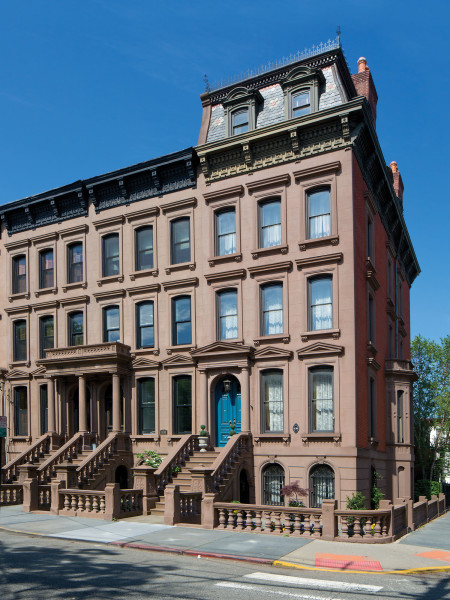
On a fashionable street in Hoboken, N.J., the end row house in a cluster of four brownstones has a high-style polychrome slate mansard roof.
Gross & Daley
The Hoboken house is emblematic of the high-style Victorian brownstone. In fact, it’s the best house at the end of a prosperous row, with an extra storey and side-wall windows. In typical Victorian fashion, it is a hybrid, sharing typical Neo-Grec details with its neighbors, yet sporting a fashionable mansard roof.
Row houses are found in various iterations, despite the apparently tight design parameters. The party wall shared by neighbors—saving on construction cost and conserving heat—is based on medieval European precedent. In the U.S., row houses take on regional attributes. Philadelphia and Boston are famous for streets lined with brick Federals. San Francisco has its wood-framed Italianate and Eastlake Painted Ladies. Baltimore’s brick row houses, famous for both their well-kept white marble steps and the indignities of 20th-century Formstone siding, were built throughout the 18th and 19th centuries. Washington, D.C., Charleston, and Savannah have theirs.
By the Victorian era, row houses (both wood-frame and masonry) were even more widespread. Entire neighborhoods in St. Louis and Chicago are defined by their neat rows. A charming example is Sylvan Terrace in upper Manhattan’s Washington Heights, where 20 wood row houses, built in 1882, survive. Victorian-era Queen Anne-style row in San Francisco’s Alamo Square.
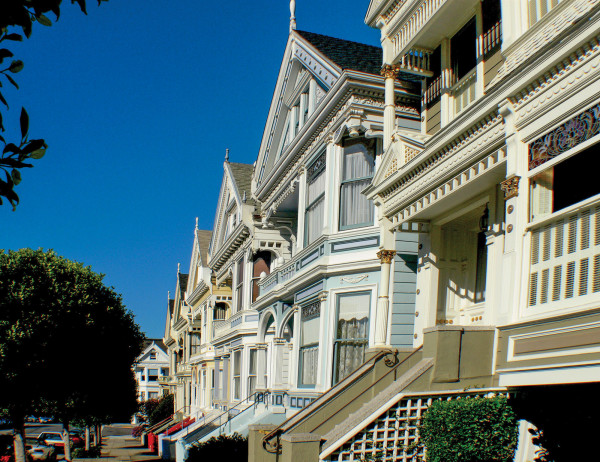
Victorian-era Queen Anne-style row in San Francisco’s Alamo Square.
Most American row houses were built in pre-platted blocks, one or four or a whole row at a time. Most housed a single family (and servants). They are narrow—12′ to 25′ wide—and normally just one room plus hall across the width, three rooms deep. Architectural style comes from whatever the builder used to ornament the façade. The cornice, belt courses, windows, and front door provide cues to style and thus date of construction.
Row houses built during the 20th century, as early as 1910, tend to exhibit Colonial Revival sentiment, sometimes emulating surviving brick Federals.
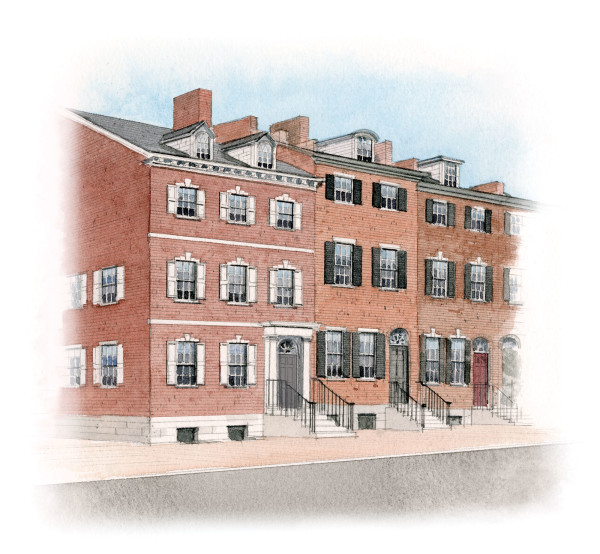
Brick Federal Row Houses, 1810s
Rob Leanna
What is brownstone?
Brownstone is a red-brown or dark chocolate sandstone, usually with a noticeable mica content. Much of the brownstone used to clad Victorian row houses in Manhattan and Brooklyn was quarried in New Jersey, making it more affordable than limestone from the Midwest. Brownstone is a sedimentary rock, meaning it consists of layers. When the stone is naturally bedded— with its strata parallel to the ground—it has longevity. When it is face-bedded— set with the layers perpendicular to the ground—it is subject to spalling from water in infitration and freeze–thaw cycles. Brownstone builders sometimes face-bedded the façade slabs to expose a long surface of stone, which is why we see brownstone deterioration today, especially around doorways.
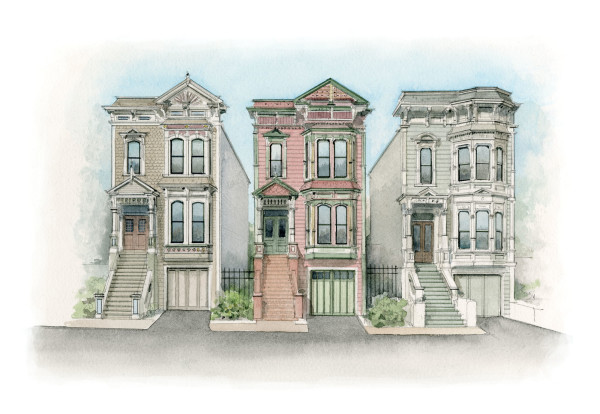
Wood-frame row houses, 1870s.
Rob Leanna
Brownstone An urban form popular in Northeast cities during the 19th century, named for its façade cladding of brown sandstone (generally over brick construction). Almost all are party-wall houses, built in rows that create a consistent streetscape. In the past 20 years, “brownstone” has, in some cities, become a generic word for 19th-century, party-wall row houses.
• Double house In this context, a house divided vertically by a party wall, designed for two families, one on each side, each house multi-storey. Each side is on its own lot. Double houses may occur in a row.
• Greystone A Chicago term for a brick building with an Indiana limestone façade, dating to 1890–1920s. Greystones range from mansions to semi-detached row houses. Unlike brownstones, which were built as single-family homes, greystone row houses were often multi-family. They often have neoclassical, Beaux Arts, or Chateauesque styling.
• Limestone A more precise term for brownstone-era houses clad with white or pale grey limestone. Limestones may occur in short or long rows, or be interspersed with brick or brownstone façades.
• Party wall Specifically a common wall that divides two houses or units, set on the property line; it’s most often structural and provides a fire break. Also used as an adjective to describe attached row houses.
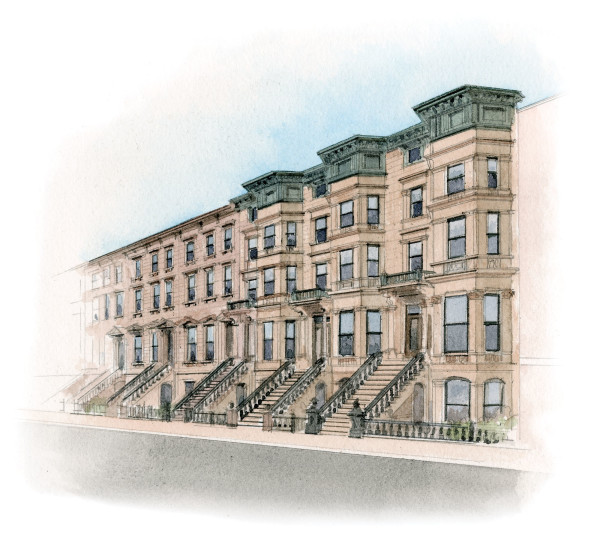
Victorian brownstones, 1880s.
Rob Leanna
• Philadelphia twin Many cities have their own version of the double house, but Philadelphia’s twin houses are famous, primarily because there are so many, beginning with those built on early streetcar lines. Bilaterally symmetrical, they look at first like one large home, but have two entries and a party wall. Subject to a unique brand of remuddling, the houses sometimes take on a comical look when two separate owners disagree on roofing, paint color, and alterations. Twins were often built in detached rows.
• Row house The term tends to favor party-wall (attached) houses, but in fact any house in a group of attached, semi-detached, or detached but tightly spaced residences with the same setback are row houses—like the wood-framed beauties in San Francisco.
• Terraced house The British term for a townhouse, generally referencing rows of identical or mirror-image houses sharing a common wall or side walls. Terraced houses date to the 16th century and are still built, but in some locales the term refers to Victorian and Edwardian examples.
• Townhouse Early on, especially in England, it was the (often tall and narrow) urban house of a family who also owned a country house. In pre-automobile days, it meant a multi-storey house on a small footprint, attached or in densely built rows. Today it means a private unit in a multi-unit row.
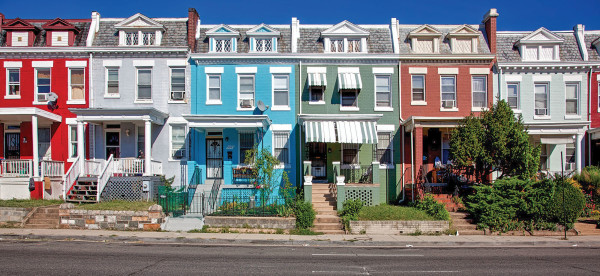
Paint colors express individuality in a row of modest brick Federal Revival houses in a 1920s neighborhood of Washington, D.C.
Courtesy Fxhere.com
Styles of Urban Row Houses
In old cities on the Eastern seaboard, row houses are found in almost every period style. West Coast cities exhibit Victorian styles from Italianate to Eastlake/Stick and Neoclassical. The Federal style, today most associated with brick houses from Portsmouth to Savannah, dates to ca. 1790–1830. These are usually two or three storeys and often have a dormered half-storey attic. The Greek Revival style that followed, ca. 1825–1860, is bold and linear, based on plain, Greek post-and-beam architecture. More ornamental is the Gothic Revival style, which overlapped the Greek and was popular until about 1860. The massing of these row houses may be similar to other styles, but Gothic features pointed arches, lancet and oriel windows, and carved stone.
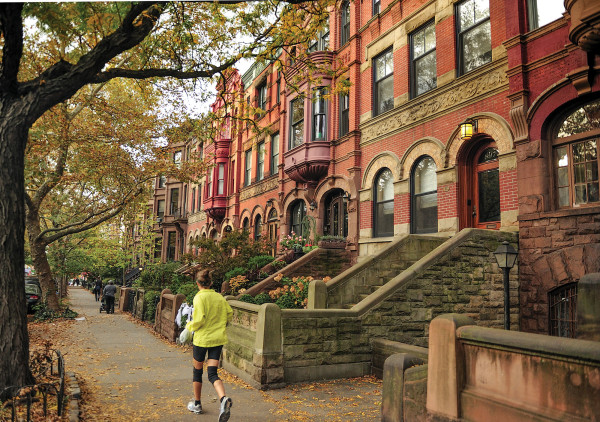
These brick, Romanesque Revival houses in Park Slope, Brooklyn, feature characteristic arches and brownstone details.
Courtesy Brooklyn Borough Guide
The Italianate style of the 1860s through 1880s is the most common style used for brownstones, as well as row houses in San Francisco. Three to five storeys, they are often symmetrical, with round-top doors or windows, and layered with ornament including large brackets. Nearly as common during the period, the Neo-Grec style returns to more severe detailing, often with columns, architraves, and pediments over doors or windows. Neo-Grec brownstones often have ornamental carvings or incising in the stone.
Gaining popularity during the 1860s, High Victorian Second Empire has many motifs in common with the Italianate style, but it is distinguished by its steep mansard roof. Look for rococo details and curved windows. Highly ornamental Queen Anne row houses date to about 1872–1900. Whether brick, brownstone, or wood-framed, these houses exhibit multiple surface textures, asymmetry, and an abundance of ornament: multi-pane windows, brackets and pendants, embellished bargeboards at eaves, starbursts, and free classic motifs. The Romanesque Revival style (about 1880 to 1890) features mixed materials, bold architecture, and round arches. With flower and wreath motifs, the classical Renaissance Revival style was used for New York rows ca. 1880 to 1920, as well as for wood-framed row houses.







